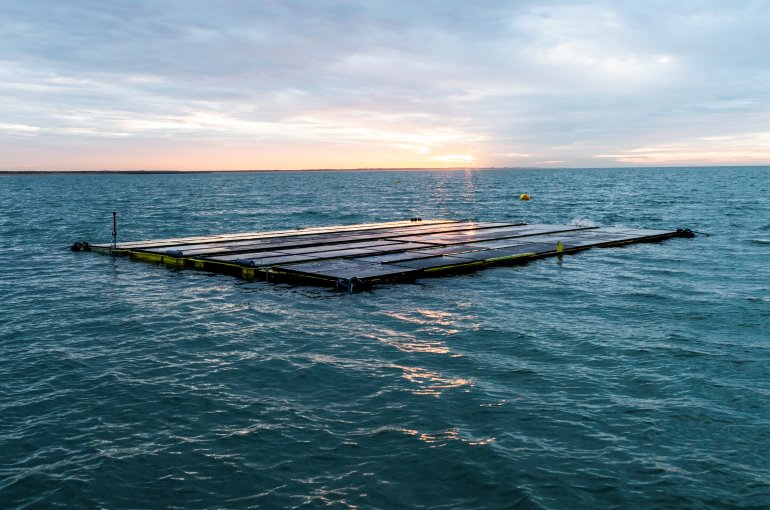Solar panels at sea: a sunny future

Many roofs in the Netherlands are kitted out with solar panels: one in eight houses has them. A disadvantage of solar panels on roofs is that there are often taller structures nearby, so that some of the panels lie in the shadow of trees, chimneys or satellite dishes. And at some point, space for more solar panels will run out. On land, at least; but what if you could install solar panels at sea? Sara Golroodbari received her doctorate on 4 June 2021 on exactly that subject. According to her PhD research, solar panels are more efficient at sea than on land, wind has an unexpectedly positive effect on that efficiency, wind farms and off-shore solar panels can be combined, and shade sometimes has a positive effect on the electricity that is generated. We give you an overview of her most important results.
Floating solar panels at sea: higher yields, better for the landscape
Installing solar panels at sea preserves the landscape and frees up valuable land for agriculture. But how much energy will they generate? Golroodbari and Wilfried van Sark created a computer model for floating solar panels that simulated the effects of wind, waves and temperature. “Floating solar panels at sea perform almost 13% better on average than panels installed on land, and in some months they even generated 18% more energy. The difference is due to the lower temperatures at sea and less cloud cover.”
Unexpected positive effect of wind on floating solar panel yield
Golroodbari also tested the effect of the wind on how much electricity the floating solar panels generate. This yielded a surprising result: the stronger the wind, the less efficient the solar panels are. Up to a certain point, where the yield goes up again.

This has to do with the water surface’s reflection: when there is a small amount of wind, the rippling surface of the water causes the sun to be reflected randomly, and fewer rays reach the solar panels. However, when the wind moves with speeds faster than 7.6 metres per second (about 27 km/h), whitecaps form on the waves, which in turn make the reflection of sunlight so strong that the yield increases again. This is favourable for Dutch off-shore panel parks: the wind there is often stronger than 7.6 metres per second.
Combining offshore wind farms with floating solar panels: more efficient use of space and cables
The wind farms in our North Sea logically only generate energy when it is windy, and there is a lot of empty space between the turbines. How can the capacity of those farms be utilised more efficiently? Firstly, by partly filling in the empty space with floating solar panels. Additionally, in periods when wind energy cannot be maximally produced, the energy generated by solar panels can be transported via the wind farm cable. This concept is called cable pooling.
Golroodbari’s research showed that such a hybrid form of wind and solar energy in the North Sea results in higher yields in most cases. Results from this paper contributed to the 'Routekaart zon op water' that was presented to the Dutch House of Representatives in early February.
A new shade-resistant prototype
Because clouds reflect sunlight back to the earth's surface and the solar panels located there, clouds do not necessarily have a negative effect on the yield of solar panels. Even if a tiny part of a solar cell in a solar panel is shaded, the energy output can be significantly affected. Solar panels at sea have to deal with shade from, for instance, wind turbines and bird droppings. That is why Golroodbari has developed a prototype of a solar panel that is more resistant to shadows. Solar panels usually consist of about 60 cells. The new solar panel groups these cells in an electronic way, so that a smaller part of the panel fails when a small part is in the shade.
Publication
Mirbagheri Golroodbari, S.Z., 2021. The sun is rising over the North Sea: assessment of offshore solar photovoltaics. ISBN: 978-94-6416-590-6

